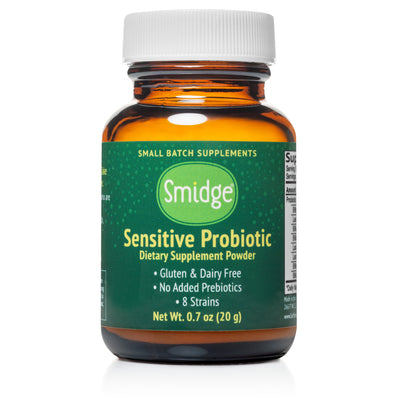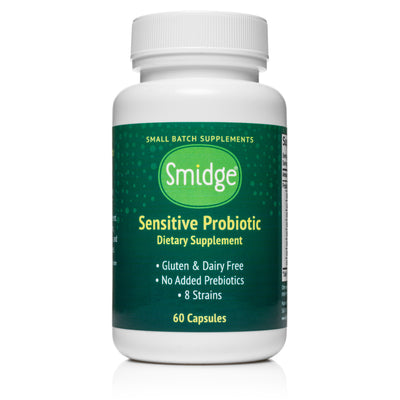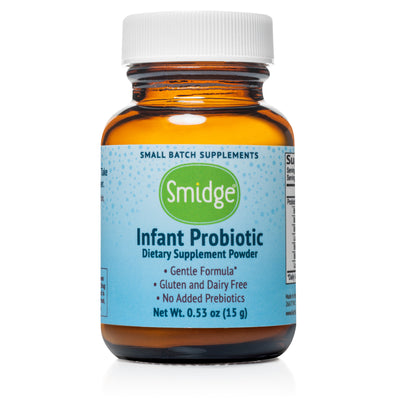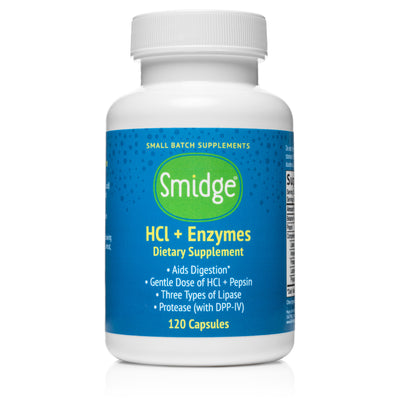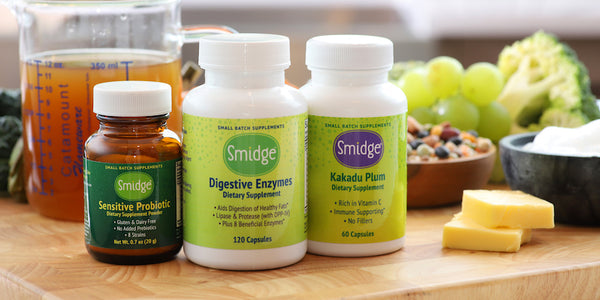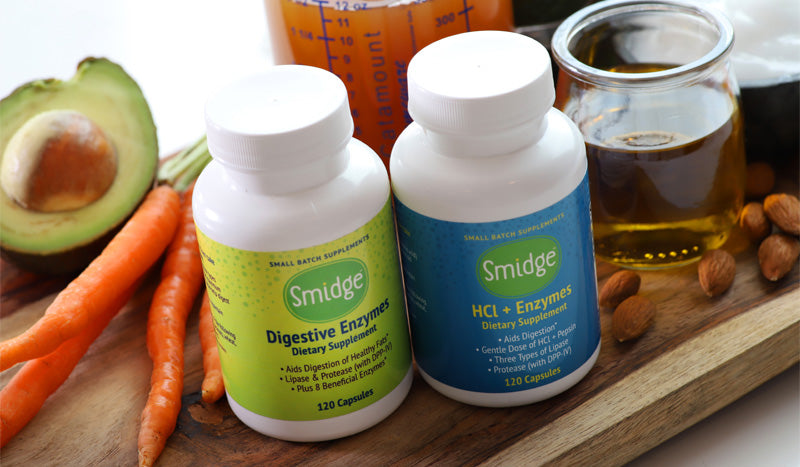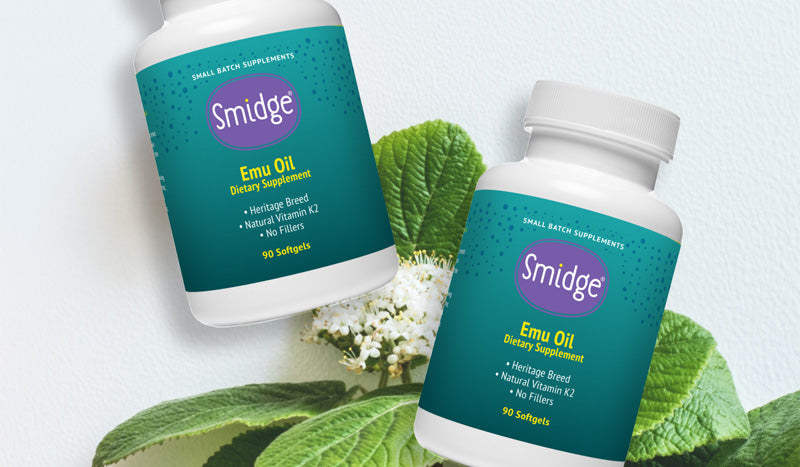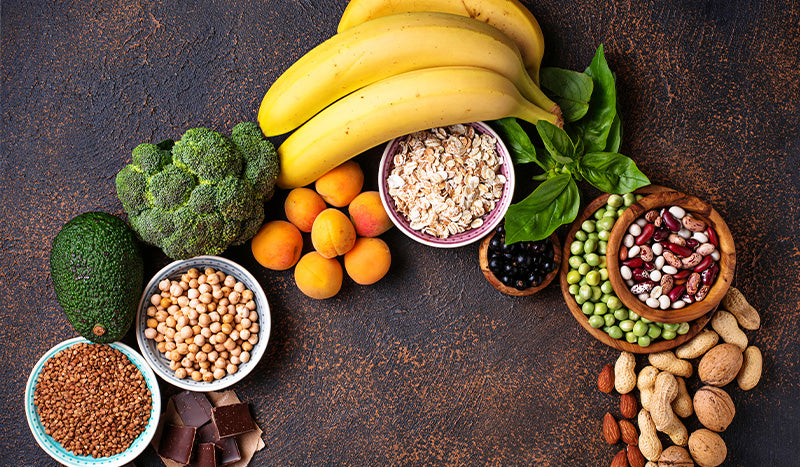New in! Smidge® Wheat Germ Oil liquid for a potent and natural food source of vitamin E
The health benefits of vitamins, like A, C and D are splashed everywhere from our textbooks to our newsfeeds. But it’s just as important to make room on your plate for vitamin E.
When browsing for vitamin E supplements, you’ll likely hear the term tocopherols, a group of fat-soluble phenolic compounds that comprise the major forms of vitamin E. Fat-soluble means the vitamin E is absorbed by our bodies when taken with high-quality fats in our diet. It’s then carried into our bloodstream and performs essential functions (and the extra is stored in our fat for later use). Here are the big ones:
- Vitamin E acts as an antioxidant to support cellular membrane function.*
- It supports the immune system.*
- It promotes healthy skin.*
- Vitamin E may support blood circulation and the flow of oxygen in the blood.*
- And it may support eye health.*
But the source of your vitamin E matters: Obtaining vitamins from real food rather than processed supplements means your body will soak up and use this nutrient as nature intended.
Meanwhile, most supplemental vitamin E is derived from soy and semi-synthetic. There are several issues with synthetic vitamins and synthetic vitamin E. To start, they’re less effective and bioavailable than the natural forms you can get from food.* Further, the synthetic form of vitamin E can cause health issues in other parts of the body.* For more on this, click here.
Enter Smidge® Wheat Germ Oil
Smidge® Wheat Germ Oil liquid is the latest to join the shop — on the heels of its companion, Wheat Germ Oil softgels. It contains a full spectrum of tocopherols, which means it maintains all of the original alpha-, beta-, gamma- and delta-Tocopherols.
We created these products so you can get your vitamin E naturally, as wheat germ contains the highest amount of the vitamin out of any other food.* We only use pure wheat germ oil, made from fresh, non-GMO North American wheat. It’s cold-pressed to retain its natural nutrients, including omega-3 fatty acids and phytosterols (plant-based molecules related to cholesterol).* It’s also free of additives and made in small batches to preserve that freshness.
If you’ve never heard of it, wheat germ is the wheat plant’s embryo; it contains the highest amount of nutrients in the entire wheat kernel.
As mentioned above, the form of vitamin E found in wheat germ oil is known as tocopherol, which acts as an antioxidant (and is often added to other foods and oils to keep them fresh). Antioxidants are compounds that help protect the body from free radicals, which are harmful substances that can damage cells, build up and lead to chronic health issues over time.*
Cooking with Wheat Germ Oil and getting more vitamin E from foods
Aside from sipping the liquid plain off the spoon, you can use Smidge® Wheat Germ Oil in foods as an easy way to add nutrition to almost any dish.
Here are some ideas on how to use wheat germ oil with your favorite staples (note that the foods listed also include good fats that will help you to absorb the vitamin E):
-
Add it in small amounts to olive oil in homemade dressing.
-
Drizzle it over pasta, mixed in with some melted butter, ghee, or olive oil.
-
Toss it with cheeses, meats and veggies for a lovely peasant salad.
-
Add drops of Wheat Germ Oil to soups and sides.
-
Blend it with smoothies or yogurt that include some fats like avocado, organic whole milk, full-fat coconut milk or coconut oil.
-
Or spoon some over your steel-cut oatmeal or granola, with peanut butter, a dollop of yogurt or some full-fat milk.
Avoid frying with it as heating the oil too high causes the nutrients to decline.
In addition to enjoying Wheat Germ Oil with your favorite staples, you can get vitamin E naturally in a variety of foods:
- Nuts (such as peanuts, hazelnuts, almonds) and seeds (like sunflower seeds) are also among the best sources of vitamin E. And go organic when you can :)
- Green vegetables, such as spinach and broccoli, provide some vitamin E and get better absorbed when lightly steamed and paired with butter, ghee, coconut oil, cheese, etc .
- Pumpkin, avocado and mango.
Food companies add vitamin E to some breakfast cereals, fruit juices, margarines and spreads, and other foods. But this is synthetic vitamin E and should be avoided, as well as the trans fats and processed ingredients in many of these foods.
What’s best for you, Wheat Germ Oil liquid or softgels?
Here are the key differences between Smidge® Wheat Germ Oil liquid and the softgels.
Liquid:
- Smidge® Wheat Germ Oil liquid has no fillers or the added ingredients sometimes required to make capsules. (The only additional ingredients in our Wheat Germ Oil softgels are gelatin bovine, glycerine and purified water to create the natural softgels.)
- People who have trouble swallowing capsules prefer the ease of taking the liquid.
- And, those who enjoy using Wheat Germ Oil in cooking like the liquid.
Softgels
- People who want to limit the amount they take per serving because of their sensitive digestive systems often opt for the softgels.
- Folks who want a quick and convenient way to take their oil go for the softgels, too.
And the taste of the liquid is pleasant; it’s smooth, light and slightly nutty with a gentle wheaty aftertaste.
Dosing for vitamin E with real food wheat germ oil — less is more

The Recommended Dietary Allowance (RDA) for vitamin E for males and females ages 14 years and older is 15 mg daily (or 22 international units, IU), including pregnant women. The RDA calls for slightly more for lactating women, at 19 mg (28 IU) daily.
Doses of synthetic vitamin E can range from 50 IU to 1,000 IU, which is well above the RDA and can contribute to health issues, as we discussed above. This is because too much vitamin E can become a pro-oxidant (a chemical that contributes to oxidative stress), which causes the opposite of an antioxidant's desired effect.
To compare, a teaspoon serving of Smidge® Wheat Germ Oil liquid contains 5.3 mg of vitamin E, which is less than half the RDA and far below what’s provided in synthetic supplements. This is actually a benefit! True to our philosophy, the Wheat Germ Oil liquid will yield a low dose and it comes from food, making it much safer and more absorbable.* This is the crux of our company, taking smidge-like serving sizes of any supplement that are tailored to a person's unique, bio-individual needs. Because taking less than the standard recommended dose may be all that you need.
And remember, vitamin E is fat-soluble and can be stored in the body, so there’s no need to overdo it :) Especially since it’s a micronutrient — an essential element needed by the body but best consumed in small amounts.
- This blog post was reviewed by Karen Myers, a co-owner of Smidge®. Karen has 20 years in the holistic health field and is a Certified Nutritional Therapy Practitioner. Learn more about Karen here!
Warning: People who are taking blood-thinning drugs should avoid taking large doses of vitamin E. And, because Smidge® Wheat Germ Oil is minimally processed to preserve the natural nutrients, the oil may contain trace amounts of gluten and should be avoided by those with celiac disease and severe wheat allergies.
